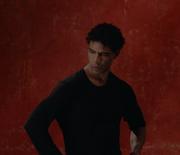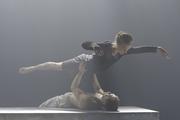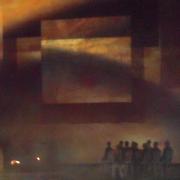Kim Brandstrup
Cinematic space and multimedia (2001-2010)
Cinematic space and multimedia (2001-2010)
A cinematic approach to the theatrical space was abundantly evident from the very beginnings of Kim Brandstrup’s career as a choreographer. Having done a degree in Cinema before coming to London and starting choreographing all his early works were meticulously storyboarded – diagram’s of placing and directions, curved arrows to indicate motion, stick drawings of dancers in the space.
' These early pieces were probably storyboarded within an inch of their lives - much too controlled, too held - but I think the idea of cutting, superimposing, cross fading, having parallel action were my attempt to achieving some kind of control over the movement which so often takes over – dancing has such an seductive and unstoppable compulsion to flow and continue – slip out of your hands. These works (and using these filmic strategies) were wrestling with finding some kind of punctuation, some kind of syntax, structure – to attempt speech through the movement.'
From his many collaborations with designer Craig Givens through his work with artist/filmmakers The Brothers Quay to his current series of works with stage designer Richard Hudson, all have sought to create fictional universes and lucidly suggestive spaces that allow for rapid shifts in time and space.
. In his early work, before using actual sets, lighting ,through his many collaborations with Tina McHugh, was an invaluable tool in creating a sense of cinematic ‘editing’. Thus, in all of Brandstrup’s works, the curtain raises on another world – often ambiguous, mysterious and suggestive – never a literal location, rather a world of potential.
As video and digital technology made rapid advances in the late 1990s it was obvious that Brandstrup would seize the opportunity to work with new media.
“ I think it was Merces’s (Cunningham) use of front gauze projection in ‘Biped’ and Steven Scotts video work for Will Tucketts ‘Turn of the Screw” that really got me interested and made me realise the potential the technology could offered - prior to this video was used for momentary effects like moving clouds , falling rain effect
In 2001 he created The Queen of Spades for Les Grand’s Ballets Canadiens – the first full-length ballet made exclusively with video projection. The entire piece was performed in a virtual space, with imagery created by The Brothers Quay and Silvain Roberts projected onto gauzes, allowing for fantastical and radical narrative shifts. Brandstrup continued to refine and hone his video experiment, working again with The Brothers Quay on his homage to Hans Christian Andersen, Anatomy of a Storyteller (2004) and revisiting his collaboration with Steven Scott in Ghosts for the Royal Danish Ballet in Copenhagen (2007).
Most recently, his collaboration with video designer Leo Warner in Goldberg: The Brandstrup/Rojo Project (2009) took its audience on an eerie journey to the space beyond our immediate reality, where the shadows and flashes cut through a bare rehearsal room setting to remind us of a world beyond.

Faces
Lucie Conrad
ROH Linbury Theatre , September 22 2018
Cinematic space and projection, Complete Works
Kim Brandstrup’s latest film project, Faces, is an intimate portrait of three extraordinary dancers - Carlos Acosta, Alina Cojacaru and Zenaida Yanowsky - caught in the magical moment of time as each listens to music and prepares to move.
The triptych of short filmed portraits, with music by François Couperin, had its first public screenings during Open House London, when the Royal Opera House opened its doors to the public to reveal the newly refurbished Linbury Theatre, September 22, 2018.

Leda and the Swan
Royal Ballet
Royal Opera House, Covent Garden , 5 September 2014
Ballet, Film/Theatre
"Kim Brandstrup’s masterly Leda and The Swan, which mingles Yeats’s poetry (read by Fiona Shaw) has the texture and heft of proper film-making. Zenaida Yanowsky and Tommy Franzen are transfixing."
-Sarah Compton,
The Telegraph

Death In Venice
Complete Works, Opera
"There are subliminal echos of the Rite of Spring in the young boys games on the beach (choreographed with great natural ease by Brandstrup), where the one sacrificed is no longer the Chosen One (Tadzio) but the Elder (Aschenbach)."
Le Mond

Rushes - fragments of a lost story
The Royal Ballet
The Royal Opera House, 23 April 2008
Ballet, Cinematic space and projection, Complete Works, narrative experiments
“One of the richest and most dramatic new ballets seen on the stage of the Royal Opera House for a good long time. A sensual, fluid creation.”
Sarah Crompton, Daily Telegraph

Queen of Spades
Les Grandes Ballets Canadiennes
Theatre Maisonneuve of Place des Arts, Montreal, October 2001
Ballet, Cinematic space and projection, Complete Works, narrative experiments, Full Length Works
“A royal flush!" "The Queen of Spades: The choreographer has played his cards very well by artfully blending modernity and classicism." "... the clarity of action, the delicacy of movement, the lovely music, and, most of all, the understated aestheticism leave you breathless throughout the ballet."
- Linda Boutin, Voir,